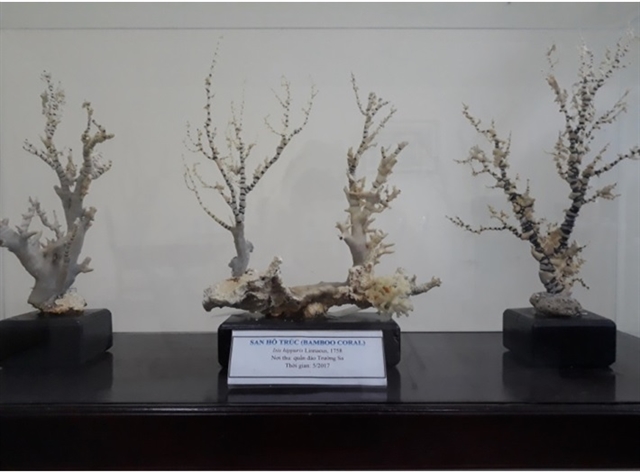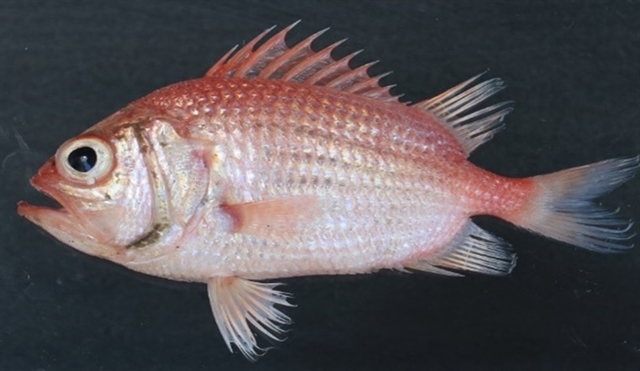
Bamboo coral, collected around the Song Tử Tây Islands of the Spratly Archipelago, are on display at the Institute of Oceanography. Photo courtesy of the Institute of Oceanography
HÀ NỘI – Scientists from the Institute of Oceanography under the Vietnam Academy of Science and Technology have completed a collection of more than 20,000 specimens of sea creatures, with many new creatures discovered for the first time in Vietnamese waters or entirely new species.
This is the result of the national Project on Building a National Collection of Natural Creature Specimens.
Deputy Director of the Institute of Oceanography Hoàng Xuân Bền, who is responsible for directing the project, said that this is a large-scale and long-lasting piece of research.
The project aims to obtain a set of specimens of about 50 per cent of all marine species in the southern region for display and research that meet the standards of the Vietnam National Museum of Nature, and contribute to completing the national collection of natural specimens for research and display.
It also aims to improve the research capacity and skills of classifying sea creatures to support research on biodiversity to serve conservation and education on the marine environment.
The collection includes more than 20,100 specimens of plankton, plants, invertebrates and vertebrates which were discovered and collected in the 2015-2020 period. Of that, 2,626 specimens are for display and the rest are for research.
Bền said the organisation of field trips to collect, process and preserve specimens at sea was difficult due to the large sampling area stretching from Đà Nẵng to Kiên Giang, and diverse specimens in the deep and offshore areas in the Paracel and Spratly Archipelagos.
The classification of species and number of specimens collected was based on existing documents such as the Vietnam Red Book or the Vietnam Fauna and Flora guide. However, when scientists expanded the collection area, some rare species could be obtained in large quantities while some others decreased in number, even though the location and sampling method was the same.
"In order to collect specimens in the Spratly islands, we sought the support of Naval Region 4 and were allowed to collect samples using navy ships. We were also given the support of the Vietnam Academy of Science and Technology when collecting samples in offshore waters by the Academic Oparin research ship from the Russian Academy of Sciences and support from fishermen on Lý Sơn Islands when collecting specimens in the Paracel islands.
New sea creatures discovered
During the project, scientists have identified many new organisms that were first discovered in Việt Nam's waters or new species entirely.

Sơn fish is newly discovered in the waters around the Paracel islands.
Dragonets have been recorded in the waters of southern Bến Tre Province and seven other species of fish were discovered in the waters of Đà Nẵng, Quảng Ngãi, Bình Định and Nha Trang.
New soft corals have been reported in the waters of Cù Lao Chàm, Lý Sơn, Nha Trang and Ninh Thuận. Two new specimens of sponges have been found in the waters of Khánh Hòa, Ninh Thuận, Côn Đảo, Phú Quốc and Thổ Chu.
“These results show that the southern sea of our country still has a lot to discover,” he said.
Bền said in order to conserve and develop biodiversity in southern seas, there should be specific solutions such as strengthening management activities in sustainable exploitation of coastal resources, especially coral reefs, seagrass beds, mangroves and coastal wetlands.
Authorised agencies and local authorities needed to effectively manage marine areas and other important habitats; restore degraded habitats; develop appropriate policies in the management of marine resources, and raise people's awareness of compliance with the law in the exploitation and use of marine resources.
In particular, policy-makers needed to focus on investing in scientific research, including surveys and assessments of biodiversity of marine creatures in the southern seas, he said.
All specimens are on display at the Institute of Oceanography. VNS
OVietnam